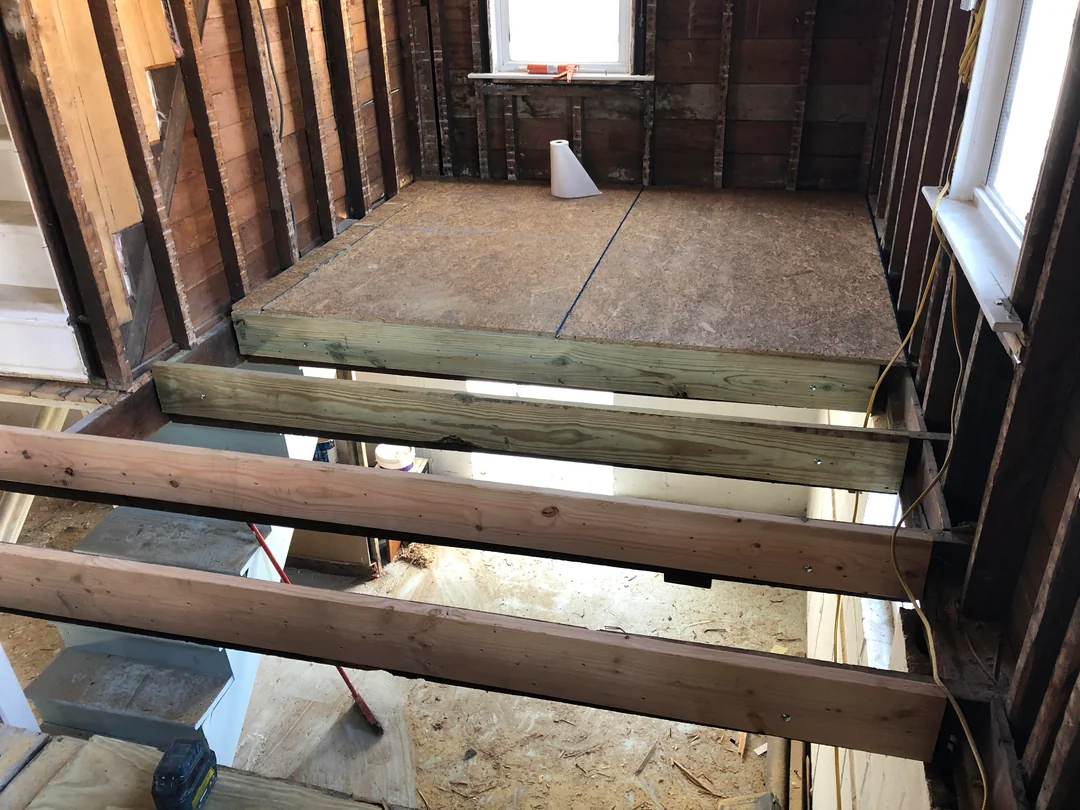When it comes to home renovation or repair, one crucial aspect that often requires attention is the condition of the floor joists. Over time, joists can become weak or damaged due to various factors, such as moisture, termites, or simply old age. To ensure the structural integrity of a building, sistering joists—reinforcing existing joists by attaching new ones alongside them—becomes necessary. Understanding the building code requirements for this process is essential to avoid complications and ensure safety. This guide offers a comprehensive overview of the steps involved in sistering joists, explaining the building codes, materials, tools, and techniques required, while emphasizing the importance of adhering to local regulations.
Understanding the Basics of Sistering Joists
What is Sistering?
Sistering joists is the process of attaching a new joist to an existing one to strengthen or repair it. This method is commonly used when a joist is damaged, sagging, or otherwise compromised. The new joist, known as the “sister,” is typically placed alongside the original joist and secured with screws or nails, effectively doubling the strength of the floor structure.
When is Sistering Necessary?
Sistering becomes necessary under several conditions:
- Damage from Moisture: Water damage can cause wood joists to rot, weaken, or warp, making them unsafe to support the load they were originally designed to bear.
- Termite Infestation: Termites can eat away at the wood, significantly reducing its strength.
- Excessive Sagging: Over time, joists may sag due to the constant load, leading to uneven floors and potential structural problems.
- Reinforcement for Load-Bearing: When adding additional weight to a floor, such as installing heavy equipment or adding a new room, sistering can be used to increase the load-bearing capacity of the existing joists.
Building Code Requirements for Sistering Joists
Importance of Adhering to Building Codes
Building codes are established to ensure that construction practices meet safety and structural integrity standards. When sistering joists, it is crucial to follow these codes to avoid legal issues, ensure the safety of occupants, and maintain the structural stability of the building. Non-compliance can lead to fines, the need for costly repairs, or even the failure of the structure.
General Building Code Guidelines
While building codes can vary depending on location, some general guidelines apply to most areas:
- Joist Size and Type: The new sister joist must be of the same size and type as the existing joist. For example, if the original joist is a 2×8, the sister joist should also be a 2×8.
- Fastening: Building codes often specify the type, size, and spacing of fasteners (nails, screws, or bolts) to ensure the new joist is securely attached to the old one.
- Length of Sister Joist: The sister joist should extend as far as possible along the length of the original joist, ideally from one end to the other, to provide maximum reinforcement.
- Permits: In many areas, obtaining a building permit is required before beginning the sistering process, especially if the work involves structural changes.
Specific Requirements
Specific requirements for sistering joists may include:
- Nail or Screw Spacing: Codes may dictate that fasteners must be placed every 6-8 inches along the length of the sister joist, and a specific distance from the edges to avoid splitting the wood.
- Use of Adhesives: Some codes recommend or require the use of construction adhesives in addition to fasteners to create a stronger bond between the old and new joists.
- Inspection: A local building inspector may need to approve the work before and after the sistering process to ensure compliance with all relevant codes.

Step-by-Step Guide to Sistering Joists
Materials and Tools Needed
Before beginning the sistering process, gather the necessary materials and tools:
- Materials:
- Sister joists (same size and type as existing joists)
- Construction adhesive
- Galvanized nails or screws
- Metal joist hangers (if needed)
- Tools:
- Measuring tape
- Circular saw
- Hammer or drill
- Level
- Pry bar
- Safety gear (gloves, safety glasses, etc.)
Preparing the Area
- Inspect the Existing Joists: Thoroughly inspect the joists to determine the extent of the damage. Identify any areas where the joist is severely weakened or sagging.
- Clear the Work Area: Remove any insulation, debris, or obstructions that may interfere with the sistering process.
- Measure and Cut the Sister Joists: Measure the length of the existing joist and cut the new sister joist to match. If possible, extend the sister joist the full length of the existing joist for maximum reinforcement.
Installing the Sister Joists
- Apply Construction Adhesive: Apply a generous amount of construction adhesive to the side of the existing joist where the sister joist will be attached. This helps to create a strong bond between the two pieces of wood.
- Position the Sister Joist: Place the sister joist alongside the existing joist, ensuring that it is level and aligned properly.
- Fasten the Joist: Using galvanized nails or screws, attach the sister joist to the existing joist. Start at one end and work your way to the other, spacing the fasteners according to local building codes. Be careful not to overdrive the nails or screws, as this can weaken the connection.
- Secure Both Ends: Ensure that both ends of the sister joist are securely fastened to the existing joist. If the sister joist does not extend the full length of the existing joist, use metal joist hangers to secure the ends to the supporting beams.
- Check for Level: After fastening, check the new joist with a level to ensure it is even. Make any necessary adjustments before the adhesive sets.
Finalizing the Installation
- Inspect the Work: Double-check all fasteners and connections to ensure everything is secure and in place.
- Reapply Insulation: If you removed any insulation during the process, reinstall it around the newly sistered joists.
- Clean Up: Clear the work area of any tools, debris, or leftover materials.
Common Challenges and Solutions
Working in Tight Spaces
One of the most common challenges when sistering joists is working in tight or confined spaces, such as in basements or crawl spaces. To overcome this:
- Use Shorter Sections: If you cannot install a full-length sister joist, consider using shorter sections that can be maneuvered into place and connected with overlapping joints.
- Invest in Compact Tools: Using smaller or more compact tools, such as a mini circular saw or right-angle drill, can make it easier to work in tight spaces.
Dealing with Obstructions
Pipes, wiring, or ductwork can often get in the way of sistering joists. In these cases:
- Notching the Sister Joist: If necessary, you can notch the sister joist to fit around obstructions, but be sure to follow local building codes regarding the size and placement of notches.
- Relocating Obstructions: If possible, consider relocating obstructions to create a clear path for the sister joist. This may require additional work, such as rerouting wiring or plumbing, but can result in a stronger and more effective repair.
Safety Considerations
Personal Safety
When working on any construction project, including sistering joists, personal safety should be a top priority. This includes:
- Wearing Safety Gear: Always wear appropriate safety gear, such as gloves, safety glasses, and hearing protection.
- Using Tools Properly: Follow the manufacturer’s instructions for using tools and equipment, and ensure they are in good working condition.
- Working with a Partner: Whenever possible, have someone assist you with the work, especially when lifting heavy materials or working in confined spaces.
Structural Safety
Ensuring the structural safety of the building is equally important:
- Avoid Overloading the Structure: Be mindful of the weight of the materials and the load-bearing capacity of the existing joists. Overloading the structure can lead to further damage or collapse.
- Consult a Professional: If you are unsure about any aspect of the sistering process, consult a structural engineer or a professional contractor to ensure the work is done correctly.
Cost Considerations
Materials
The cost of materials for sistering joists can vary depending on the size and type of wood, as well as the number of joists that need to be sistered. On average, you can expect to pay:
- Lumber: The cost of lumber will depend on the type and size of the joist, with prices typically ranging from $2 to $5 per linear foot.
- Fasteners and Adhesive: Expect to spend around $20 to $50 on fasteners and construction adhesive.
Labor
If you choose to hire a professional to sister your joists, labor costs will be the most significant expense. Labor rates can vary widely depending on location, but on average, expect to pay between $50 and $100 per hour for a skilled carpenter. The total labor cost will depend on the complexity and scope of the project.
Permit Fees
Depending on your location, you may need to obtain a building permit before beginning the sistering process. Permit fees can vary but typically range from $50 to $200.
Conclusion
Sistering joists is an effective method for reinforcing or repairing floor joists that have become damaged or weakened over time. By following the appropriate building codes and guidelines, you can ensure that the process is completed safely and effectively, restoring the structural integrity of your home. Whether you choose to tackle the project yourself or hire a professional, understanding the requirements and steps involved is key to achieving a successful outcome.




